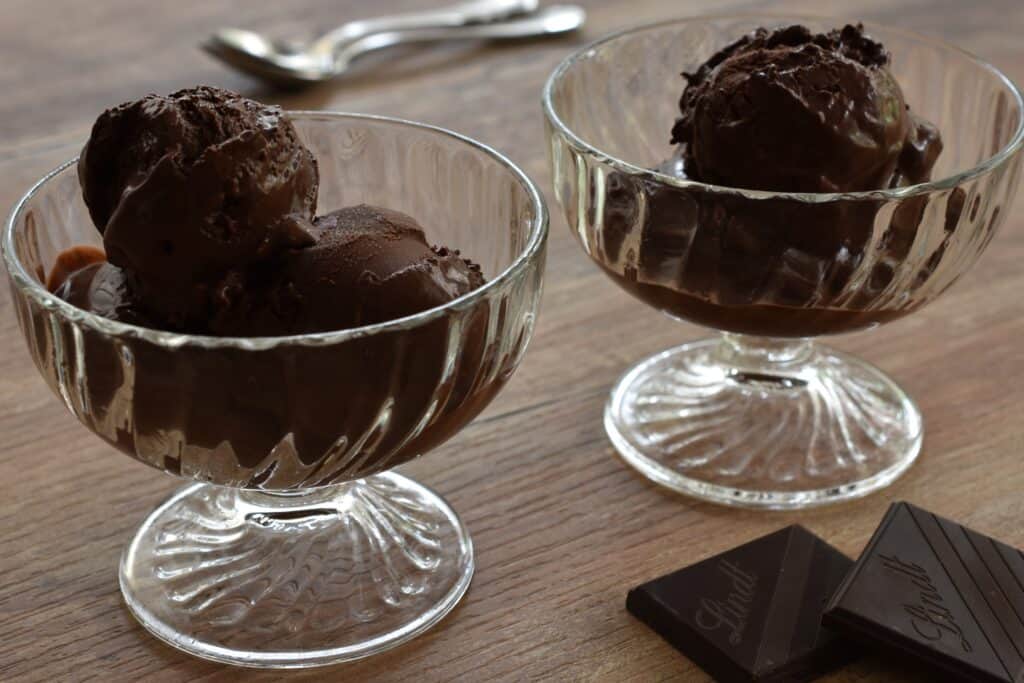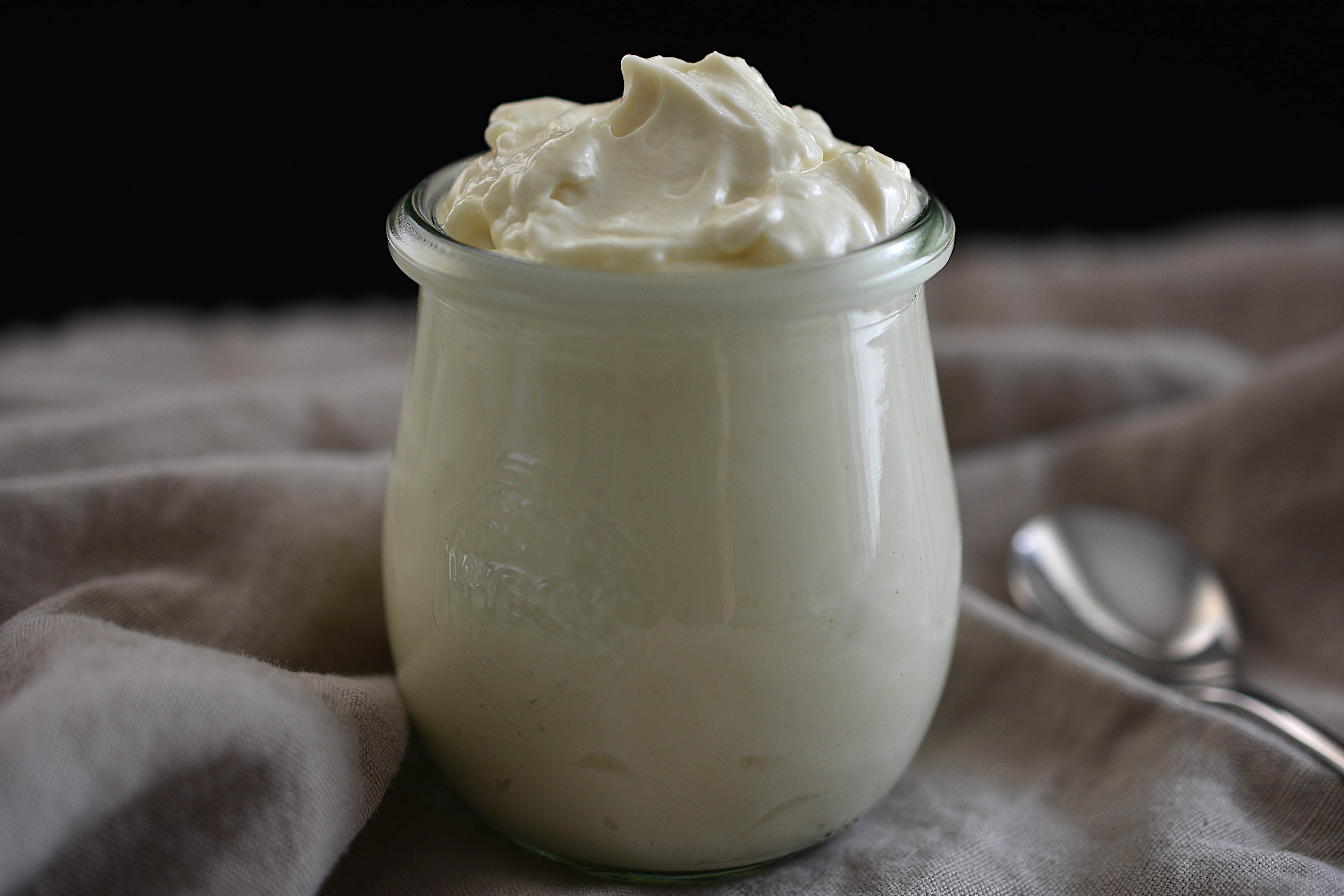This delicious homemade vegan mayonnaise is thick, light and creamy – exactly how a mayonnaise should be! It’s just as tasty as the real thing, and it’s 100% cruelty-free. What more could you want? It also has less oil than its non-vegan counterparts and, therefore, fewer calories. It’s far easier to make than traditional mayonnaise. It only takes a couple of minutes and uses a few simple ingredients that you probably already have in the house. And it tastes incredible – just like regular mayonnaise!
This vegan mayonnaise recipe requires only oil, soya milk, mustard, lemon juice, salt, and an immersion blender. Please note that only an immersion blender will deliver the desired results! Like traditional mayonnaise, the ingredients for this eggless mayonnaise must be at room temperature.

The best vegan mayo
There are so many advantages to this easy vegan mayonnaise recipe: no carefully adding the oil a little at a time, no constant whipping, no risk of it curdling, and no risk of salmonella contamination. The simplicity of this recipe makes me wonder why mayonnaise was ever made with eggs in the first place! I find this plant-based mayonnaise recipe particularly useful when you need larger quantities of mayonnaise. Shop-bought vegan mayo usually has undesirable ingredients like emulsifiers, stabilisers, and preservatives. If you make your own homemade vegan mayonnaise, you have full control over the ingredients.
This failproof vegan mayo recipe is particularly suitable for coleslaw, potato salad, Russian salad, and other recipes requiring large amounts of mayonnaise. I usually have a tube of shop-bought vegan mayo on hand in the fridge for when I need to squirt a small amount onto a sandwich. But when you need larger amounts, homemade is always better, cheaper, and healthier.
This recipe is beyond simple and a great egg-free substitute for mayonnaise. Even your pets could make it (if they have paws). Just put all the ingredients into a tall container wide enough to accommodate your immersion blender and blend for 5 – 8 seconds. That’s it, done! This is probably the best vegan mayonnaise recipe you’ll ever try! Let me know what you think in the comments.

Important
- The oil and the soya milk must both be at room temperature.
- This mayonnaise will only emulsify using an immersion blender.
- It will whip in a matter of a few seconds, so be careful not to over-blend it. Otherwise, it may become too thick and lumpy-looking.
- Move the immersion blender up and down as you blend to ensure uniform emulsification. Emulsification requires the oil to be broken down into tiny droplets and dispersed throughout the water-based ingredients (in this case, soy milk and lemon juice). By moving the immersion blender up and down, you create the turbulence that helps break the oil into smaller droplets, allowing the emulsifiers in the soy milk to stabilise the mixture.
- I tried making it with cold soy milk and with a traditional whisk and it just doesn’t work!
How to make vegan mayonnaise
Ingredients and substitutions
You’ll find the exact quantities of each ingredient in the recipe card at the bottom of this page.
Sunflower oil
For this recipe, you need a light vegetable oil. Sunflower oil is ideal, but you could also use rapeseed oil or another similar light, neutral oil. You could also use a light olive oil, but it has a stronger flavour profile which I personally don’t like in a mayonnaise
Soya milk
This vegan mayonnaise recipe calls for plain unsweetened soya milk. Classic mayonnaise is a blend of oil, lemon juice or vinegar, and egg yolk. Egg yolks contain lecithin, a natural emulsifier that helps combine two immiscible liquids, like oil and lemon juice or vinegar.
In this recipe, unsweetened soy milk acts as the emulsifier. Like egg yolks, soy milk contains lecithin, which, when blended with lemon juice and oil, forms a thick, creamy, and stable mayonnaise. The only difference is that you need more of it. The correct ratio for perfect vegan mayonnaise is 1/3 soy milk and 2/3 oil.
I’m not sure if this recipe will work with any other kind of plant-based milk. If you can’t eat soy and want to give it a try with something else, let me know how it goes in the comments.
Mustard
Mustard is a traditional ingredient in mayonnaise, and I recommend adding it here. It gives this homemade vegan mayonnaise its delicate characteristic flavour. Just make sure you use mild mustard and not a strong variety – it’s the flavour you’re after, not heat.
Lemon juice
As with any kind of mayonnaise, you need some acidity. This is almost always lemon juice or vinegar. I prefer freshly squeezed lemon juice but apple cider vinegar would come a close second in my book. You could also use white wine vinegar or other white vinegar in the same quantity.
Salt
I recommend natural, unrefined sea salt because it’s healthier than table salt. Unrefined means it hasn’t been stripped of its beneficial naturally occurring minerals. I use Guérande grey sea salt, which is unrefined and hand-harvested in the French coastal town of the same name.
Turmeric (for colour, optional)
A pinch of turmeric acts as a natural yellow colouring similar to that of egg yolk, making this homemade vegan mayonnaise look exactly like the shop-bought stuff. Personally, I don’t bother.

Instructions
You’ll find step-by-step instructions with photos in the recipe card at the bottom of this page.
- Put all the ingredients together in a container with high sides and blend for 5 – 8 seconds until you reach the consistency of traditional mayonnaise. While you are blending, move the immersion blender up and down to facilitate amalgamation and thickening. Don’t over-blend it. It really only takes a few seconds to get smooth, creamy mayonnaise. Any longer, and it may start to become too thick and take on a lumpy appearance.
- Taste and correct the seasoning if necessary. Keep it in the fridge until you’re ready to serve it.
Uses for vegan soya milk mayonnaise
Use this soya milk mayonnaise the exact same way you would use traditional mayonnaise.
Apart from the obvious uses, such as a sandwich or burger ingredient and dipping sauce, vegan mayonnaise can also be used as a base for tartar sauce, aioli, cocktail sauce, Russian salad, coleslaw, potato salad, and any other recipe that calls for mayonnaise.




How to serve vegan mayonnaise
Serve it straight from the fridge in a small serving dish with a teaspoon so that people can help themselves. Alternatively, you could put it in a small bowl and place it in the centre of a platter of fries, potato wedges, sweet potato chips, fried tempeh, vegetables like artichokes and asparagus, vegan “meat”balls or “fish” sticks. You can serve these delicacies to your family and friends as finger food so that they can dip them into this rave-worthy mayonnaise.
How to store vegan mayonnaise
You can store this vegan mayonnaise in an airtight container in the fridge for a week to 10 days. After a few days, some liquid may pool on the top. This is nothing to worry about – just stir it in before using.
Can you freeze vegan mayonnaise?
No, I don’t recommend freezing mayonnaise. I’ve never tried freezing any kind of mayonnaise myself, but I’m pretty sure the results will be unsatisfactory due to its composition. It keeps well in the fridge and takes only minutes to make, so I recommend making it fresh whenever you need it.
I’m sure you’ll love this homemade vegan mayo recipe! If you try it, I’d love to hear about it! Let me know in the comments below, or take a quick pic and share it on social media. Don’t forget to tag me on Instagram or Facebook @vegan_hot_stuff – I love seeing your re-creations!
Frequently asked questions
How does vegan mayonnaise compare to regular mayonnaise in taste and texture?
The taste of vegan mayonnaise varies depending on the brand or recipe, but it generally mimics the flavour of regular mayonnaise. Some people find vegan mayonnaise to be lighter and slightly milder in taste than traditional mayo. Most can’t tell the difference. Vegan mayonnaise has a similar creamy and smooth texture. The emulsification is achieved using plant-based ingredients like soy milk or aquafaba (chickpea brine). While many vegan mayonnaises successfully replicate the texture of regular mayonnaise, some can be slightly thinner or more gelatinous, depending on the ingredients used.
How do I make vegan mayo without soy?
You can make vegan mayonnaise with aquafaba. However, it won’t be as thick and creamy as that made with soy milk.
Is vegan mayonnaise healthier than regular mayonnaise?
Traditional mayonnaise is higher in fat and calories because it is primarily made from oil and egg yolks. One tablespoon typically contains about 90 calories and around 10 grams of fat. Vegan mayonnaise often contains similar amounts of calories and fat, as it is also made primarily from oil. Some vegan brands and recipes may have less fat and fewer calories, depending on the ingredients used. This recipe with soy milk has approximately 25% less fat than traditional mayonnaise.
How does vegan mayonnaise thicken?
Vegan mayonnaise thickens in the same way as traditional mayonnaise. Like egg yolks, soy milk contains lecithin, which, when blended with lemon juice and oil, forms a thick, creamy, and stable mayonnaise. Aquafaba also contains emulsifying properties.
Is vegan mayonnaise gluten-free?
This vegan mayonnaise is gluten-free. Check the ingredient list on shop-bought mayo to make sure they are gluten-free.
What is a good substitute for eggs in vegan mayonnaise?
The best substitute for eggs is soy milk.
How can I make vegan mayonnaise creamier or thicker?
Increasing the amount of oil can help create a thicker and creamier texture.
Does vegan mayonnaise contain cholesterol?
No, vegan mayonnaise does not contain cholesterol. Cholesterol is found in animal products, such as eggs and dairy, which are not used in vegan mayonnaise.
I hope you liked this recipe for 2-minute vegan mayonnaise! If you did, it would be great if you could give it 5 stars and leave a comment below! It helps other readers to find my content and posts and ultimately makes my blog more successful! Thank you so much for your support! Deborah xx
Before you go, why don’t you check out some other delicious vegan dips and sauces…




Vegan basil pesto genovese


Would you like to receive my recipes as soon as I publish them? Subscribe below!







?
Thanks for leaving a review! Much appreciated.